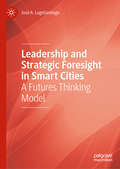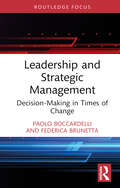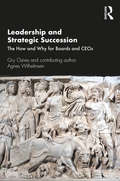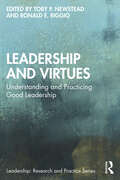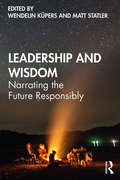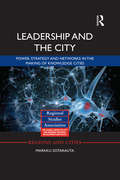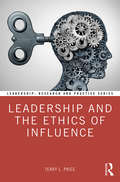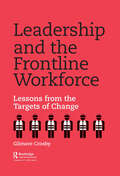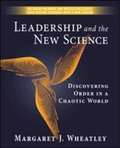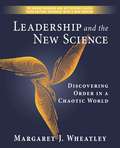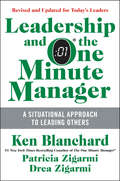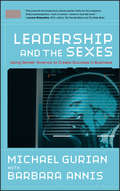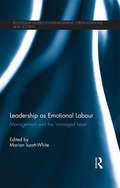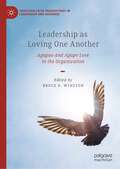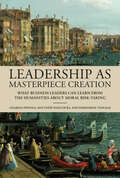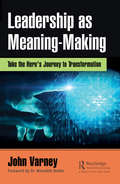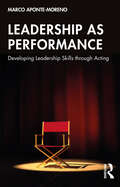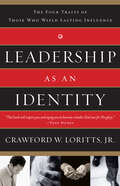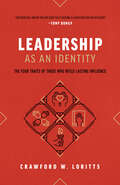- Table View
- List View
Leadership and Self-Deception: Getting out of the Box (Bus Plus Publishing Ser.)
by The Arbinger InstituteThis third edition of an international bestseller—over 2 million copies sold worldwide and translated into 33 languages—details how its powerful insights on motivation, conflict, and collaboration can benefit organizations as well as individuals. Since its original publication in 2000, Leadership and Self-Deception has become an international word-of-mouth phenomenon. Rather than tapering off, it sells more copies every year. The book's central insight—that the key to leadership lies not in what we do but in who we are—has proven to have powerful implications not only for organizational leadership but in readers' personal lives as well. Leadership and Self-Deception uses an entertaining story everyone can relate to about a man facing challenges at work and at home to expose the fascinating ways that we blind ourselves to our true motivations and unwittingly sabotage the effectiveness of our own efforts to achieve happiness and increase happiness. We trap ourselves in a “box” of endless self-justification. Most importantly, the book shows us the way out. Readers will discover what millions already have learned—how to consistently tap into and act on their innate sense of what's right, dramatically improving all of their relationships.This third edition includes new research about the self-deception gap in organizations and the keys to closing this gap. The authors offer guidance for how to assess the in-the-box and out-of-the-box mindsets in yourself and in your organization. It also includes a sample of Arbinger's latest bestseller, The Outward Mindset.
Leadership and Strategic Foresight in Smart Cities: A Futures Thinking Model
by José A. LugoSantiagoThis book examines the leadership practices and foresight needed for smart cities. The book begins by exploring the evolving definition of a smart city. Then, it considers the problems with smart cities and the need for foresight in the management of these cities. The last part of the book offers a model of strategic foresight based on understanding, anticipating, and shaping the future, with applicability to organizations. This book offers a new conception of smart cities that will appeal to researchers and policymakers interested in futures thinking and strategy.
Leadership and Strategic Management: Decision-Making in Times of Change (ISSN)
by Federica Brunetta Paolo BoccardelliManagers are facing unprecedented complexity, volatility, and ambiguity, quickly adapting their decision-making, leadership, vision, and strategies. Megatrends and forces of change have profound implications for business models, processes, and organizational structures, calling into question current paradigms and designing future change. Additionally, unprecedented disruptions, unforecastable in their nature, have increased the need for resilience and strategic flexibility.The book aims at tackling the potential interrelations among environmental transformations, strategic decisions, and leadership to better understand the role of external and internal factors on the effectiveness of managers. The book defines “change”: its extent, nature, and characteristics. Then, it focuses on decision-making, the role of potential cognitive biases, and how the interaction with the perception of determined environmental events affects the way in which decision-makers decide to implement specific strategies. Finally, in the light of waves of strategic change, it reviews theories on leadership and transformation by looking at the role and traits of leaders.Since environmental transformations have the potential to “disrupt” not only strategies but also decision-making processes and leadership, the book provides a review on the issue and propose an integrative framework which can be useful for both scholars and managers, especially in the fields of decision-making and strategy.
Leadership and Strategic Succession: The How and Why for Boards and CEOs
by Gry Osnes Agnes WilhelmsenBased on a review of the literature and several in-depth case studies, this book suggests a strategy-as-practice framework for succession and explores leadership logic, trust and followership. This book takes the reader through the key stages and disciplines required for effective top-level succession. Corporations, growing entrepreneurial companies and family owners all must manage strong group dynamics and individual needs in a succession transition. This book includes a wide range of global client cases, including public sector organizations, corporations, entrepreneurial firms and family owners. Based on rigorous research and written in an accessible style with a focus on practical needs, readers will also be able to combine this analysis within disciplines of governance, leadership, strategy and organizational development. This book will be of interest to students at an advanced level, academics and reflective practitioners as well as executives at the top levels of businesses.
Leadership and Teaming, Module Note
by Ethan S. BernsteinSmall differences in the leadership of teams can have large consequences for the success of their efforts. Many initiatives fail not because of a fatal error in judgment or insufficient ideas, knowledge, motivation, or capabilities to deliver a solution. They fail because, as is so often heard, "we needed to be more of a team to succeed," "we weren't a sufficiently high-performing team," or "our team suffered from a lack of leadership." In a world where most problems faced by organizations are too complex for a single individual to tackle alone, leadership frequently involves designing, launching, and managing teams. And yet teams are fickle. Even as teams become more common at all levels of organizations, a shocking number of them fail to live up to their potential or even to deliver at all. Teams remain the most flexible and powerful units of learning, change, and performance in most organizations but require effective leadership to succeed. This note summarizes the conditions leaders can create to increase the chances of creating, managing, and participating in successful teaming environments.
Leadership and Virtues: Understanding and Practicing Good Leadership (Leadership: Research and Practice)
by Ronald E. RiggioGood leadership is something every leader and organization should strive towards. This book serves as a pivotal resource in encouraging the understanding and practice of leadership and highlights how good leadership is anchored in the rich philosophy and science of virtue. Through a diverse range of perspectives, the book highlights the importance of leading with virtue, unpacks what it means to be a virtuous leader, and outlines practical strategies for developing and practicing good leadership. Taking a virtues perspective, this cohesive collection of chapters by scholars from around the globe offers an inclusive tone and speaks to practicing and aspiring leaders worldwide. Readers are provided with a nuanced account of the nature of virtues and leadership and how the two interact on multiple levels and in multiple ways to inform the practice of good leadership. Focusing on the tradition of virtue gives this collection a robust scholarly foundation, while simultaneously providing scope for diverse views on how and why virtues inform good leadership. The book offers a balance of scholarly and practice-oriented chapters, instilling readers with a deep understanding of virtues and leadership, and practical strategies to develop their practice of good and virtuous leadership. Each chapter offers a different moral and sociological insight, serving altogether to show readers the most effective ways to use virtues to promote shared well-being and collective success. Scholars, students of leadership and management, and leadership practitioners will benefit from the accessible and practical lessons this book has to offer. This volume will also be of interest to team leaders and managers who are keen to develop their leadership skills in both practice and theory.
Leadership and Wisdom: Narrating the Future Responsibly
by Matt Statler Wendelin KüpersLeadership and Wisdom: Narrating the Future Responsibly gives business students and practitioners the opportunity to re-read tales, poems, myths and fables that have been interpreted by leading management scholars in order to translate the world’s folk wisdom into insightful and actionable lessons for a more responsible leadership practice. Most, if not all, cultures generate narratives that teach people how to make sense of the world and how to respond to challenges with wisdom. These sources provide a medium for character, as well as a guide for decision-making in ambiguous and uncertain circumstances. Management and organization scholars increasingly focus on what narrative wisdom traditions can teach us about leadership and organizational practices, and this book is designed to bring it to students and practitioners. Statler and Küpers have assembled a world-class team of contributors, who reflect on narratives near and dear to them, and draw out the lessons for leaders. With consistency throughout and end-of-chapter questions, this book enables all readers – including undergraduate and postgraduate students of leadership, management and organization studies, as well as interested researchers and practitioners – to reflect on the contents and implications of folk wisdom.
Leadership and the Art of Change: A Practical Guide to Organizational Transformation
by Professor Lee Roy BeachLeadership and the Art of Change is a unique book in that it focuses on a leader's central and most daunting task—achieving organizational change that successfully addresses external and internal threats and opportunities. Author Lee R. Beach uses six prime responsibilities as the framework for discussing change leadership: external and internal environmental assessment to identify required changes, organizational culture as a constraint on change, vision for motivating change; plans as a map for change, implementation to produce change, and follow-through for institutionalizing achieved changes and making ongoing change a part of the culture.
Leadership and the Art of Change: A Practical Guide to Organizational Transformation
by Professor Lee Roy BeachLeadership and the Art of Change is a unique book in that it focuses on a leader's central and most daunting task—achieving organizational change that successfully addresses external and internal threats and opportunities. Author Lee R. Beach uses six prime responsibilities as the framework for discussing change leadership: external and internal environmental assessment to identify required changes, organizational culture as a constraint on change, vision for motivating change; plans as a map for change, implementation to produce change, and follow-through for institutionalizing achieved changes and making ongoing change a part of the culture.
Leadership and the Art of Struggle: How Great Leaders Grow Through Challenge and Adversity
by Steven SnyderAll Leaders Face Adversity. Exceptional Leaders Thrive in It. Leadership is often a struggle, and yet strong taboos keep us from talking openly and honestly about our difficulties for fear of looking weak and seeming to lack confidence. But Steven Snyder shows that this discussion is vital—adversity is precisely what unlocks our greatest potential. Using real-life stories drawn from his extensive research studying 151 diverse episodes of leadership struggle—as well as from his experiences working with Bill Gates in the early years of Microsoft and as a CEO and executive coach—Snyder shows how to navigate intense challenges to achieve personal growth and organizational success. He details strategies for embracing struggle and offers a host of unique tools and hands-on practices to help you implement them. By mastering the art of struggle, you’ll be better equipped to meet life’s challenges and focus on what matters most. “Leadership and the Art of Struggle provides you with the opportunity to learn from Snyder’s remarkable wisdom. It is a living guide that you can return to time and time again as new situations arise.” —From the foreword by Bill George, former CEO, Medtronic; Professor of Management Practice, Harvard Business School; and author of the bestselling True North “The leadership book of the year…one of the most intelligent, revealing, and practical books on the subject I have ever read. It confronts a vital truth: that challenge is the crucible for greatness and that these adversities introduce us to ourselves.” —Jim Kouzes, coauthor of the bestselling The Leadership Challenge “Steven Snyder covers all the bases from channeling your energy to managing conflict, including a great segment about overcoming your leadership blind spots...This encouraging book is a must-read!” —Ken Blanchard, coauthor of The One Minute Manager and Great Leaders Grow “Leadership and the Art of the Struggle gives you clear and compelling advice on transforming pitfalls into possibilities.” —Jodee Kozlak, Executive Vice President, Human Resources, Target
Leadership and the City: Power, strategy and networks in the making of knowledge cities (Regions and Cities)
by Markku SotarautaThe 21st century has been dominated by an almost compulsive race to find new pathways for city development. As cities seek to regenerate via the knowledge-based economy, now more than ever dynamic leadership is required order to navigate new and complex challenges while building community. This book is about generative leadership in knowledge city development. Leadership and the City is rooted in a conviction that the leadership in a city is crucial in order for it to adjust strategically to major transformations and thus secure a good future for its inhabitants. The book opens a fresh view of leadership by focusing on generative leaders and their modes of leading, instead of spatial categorisations, governance structures and/or policy contents and processes. It investigates generative leadership by elaborating the modes of leadership, power and strategies in influence networks. The key points are highlighted with several empirical cases. These include Akron and Rochester (USA), Münich (Germany), Leeds (UK), Barcelona (Spain) as well as Helsinki, Tampere and Seinäjoki (Finland). This book will be of interest to researchers and practitioners concerned with Leadership, Urban Studies and Strategic Management.
Leadership and the Ethics of Influence (Leadership: Research and Practice)
by Terry L. PriceHow do leaders influence others? Although they sometimes appeal directly to good reasons, which we associate with rational persuasion, leaders also use guilt, pressure, flattery, bullying, and rewards and punishment—all to get the behaviors that they want. Even when leaders refrain from outright lying, they are nevertheless known to practice something approaching, perhaps reaching, the level of manipulation. Influence therefore presents a serious ethical problem across leadership contexts. Leadership and the Ethics of Influence argues that influence puts leaders at risk of using people. It is generally disrespectful of autonomy to figure out what makes people "tick" in an effort to "handle" them. In contrast with physical force, influence works through agency, not around it. Despite this feature of influence—and, to a large extent because of it—the everyday influence associated with leadership is often morally troublesome. What matters morally is not only whether agency is bypassed or overridden but also who is ultimately in control. This book uses philosophy and leadership studies to show how leaders across different contexts can be justified in getting followers to do things. Connecting moral theory to leadership theory, and especially to charismatic leadership, authentic leadership, transforming leadership, and ethical leadership, this book is essential reading for leadership scholars, students, and practitioners.
Leadership and the Frontline Workforce: Lessons from the Targets of Change
by Gilmore CrosbyThis book is for anyone who wants to lead change. It explains change methods through real-life experiences of frontline workers. Just as history has primarily been written by the victors, leadership and management theory have been written from the top. An exception is Kurt Lewin, whose action-research established that people on the frontlines are best positioned to create and sustain change. This book’s authors have practiced that approach over two generations for the past 70 years. They were deeply influenced by the blue-collar wisdom of the author’s grandfather, an hourly worker in the railyards of Pittsburgh.Leadership and the Frontline Workforce teaches via interviews of those who were present both before and after Lewin‑style change, telling the stories of the workers who have experienced the good, bad, and the ugly of being targets of change at the bottom of systems. A colleague of the author, Cotton Mears (1956–2019), intended to write this book but only got as far as a title, “View from a target.” He was a pot room tender in Alcoa’s Warrick aluminum smelter—one of the toughest jobs in the plant—when Robert P. Crosby arrived on the scene. Their relationship launched Cotton’s own organization development career. Following Cotton’s untimely death in 2019, Robert’s son, Gilmore Crosby, felt inspired to bring this book to life.
Leadership and the New Science
by Margaret J. WheatleyThe author believes that organizations of all sizes need to recognize that traditional, unbending organizational structures are not equipped to deal with today's chaotic world. The answer lies in the "new science" Quantum Physics.
Leadership and the New Science: Discovering Order in a Chaotic World
by Margaret J. WheatleyThe new edition of the bestselling, acclaimed, and influential guide to applying the new science to organizations and management. In this new edition, Margaret Wheatley describes how the new science radically alters our understanding of the world and how it can teach us to live and work well together in these chaotic times. We live in a time of chaos, rich in potential for new possibilities. A new world is being born. We need new ideas, new ways of seeing, and new relationships to help us now. New science—the new discoveries in biology, chaos theory, and quantum physics that are changing our understanding of how the world works—offers this guidance. It describes a world where chaos is natural, where order exists "for free." It displays the intricate webs of cooperation that connect us. It assures us that life seeks order, but uses messes to get there. This book will teach you how to move with greater certainty and easier grace into the new forms of organizations and communities that are taking shape. You'll learn that: • Relationships are what matters—even at the subatomic level• Life is a vast web of interconnections where cooperation and participation are required• Chaos and change are the only route to transformation In this expanded edition, Wheatley provides examples of how non-linear networks and self-organizing systems are flourishing in the modern world. In the midst of turbulence, Wheatley shows, we create work and lives rich in meaning.
Leadership and the One Minute Manager Updated Ed: Increasing Effectiveness Through Situational Leadership II (One Minute Manager Ser.)
by Ken Blanchard Drea Zigarmi Patricia ZigarmiNewly revised and updated, Leadership and the One Minute Manager teaches leaders the world-renowned method of developing self-reliance in those they manage: Situational Leadership® II.In Leadership and the One Minute Manager, you'll learn why adapting leadership styles to team members based on their key goals and tasks is so important and why knowing when to delegate, support, or direct is critical. By consistently using Situational Leadership® II's proven model and powerful techniques, leaders can develop and retain competent, motivated, confident employees. This remarkable, easy-to-follow book is a priceless guide to personalized leadership that elicits the best performance from your team--and the best bottom line for any business.
Leadership and the Sexes
by Michael Gurian Barbara AnnisMichael Gurian's trademark use of brain science in gender studies together with real life examples of what is currently happening in business leadership make this an important resource for businesses and organizations. It provides new vision and useful practical applications, helping women and men in the workplace become more effective and fulfilled, and ultimately helping businesses and business leaders realize increased profits. Through examples and case studies from companies like Kodak, Nike, Nintendo, Home Depot, Proctor & Gamble, Avon, and Disney, the book shows readers how ignoring gender diversity actually impedes the true potential of any business.
Leadership as Emotional Labour: Management and the 'Managed Heart' (Routledge Studies in Management, Organizations and Society)
by Marian Iszatt-WhiteEven if we don’t realise it, most of us are now familiar with the idea of ‘emotional labour’; that ‘service with a smile’ which everyone from cabin crew to restaurant or call centre staff is expected to give, irrespective of what they actually feel or think. This book considers the complex ways in which this need to show (or hide) particular emotions translates into job roles – specifically those of leaders or managers – where the relationships are lasting rather than transient, two-way rather than uni-directional and have complex, ongoing goals rather than straight-forward, one-off ones. The book contends that these differences contribute unique characteristics to the nature of the emotional labour required and expounds and explores this new genus within the ‘emotional labour’ species. The main theme of this book is the explication and exploration of emotional labour in the context of leadership and management. As such, it focuses both on how our understanding of emotional labour in this context enriches the original construct and where it deviates from it. By exploring these issues at the level of situated practices and the real world, real time experiences of leaders, the book seeks to make an innovative and nuanced contribution to our understanding of the emotional element within ‘leadership work’.
Leadership as Loving One Another: Agapao and Agape Love in the Organization (Christian Faith Perspectives in Leadership and Business)
by Bruce E. WinstonThis volume explores leadership as a form of loving one’s employees, centering on the biblical concepts of Agapao and Agape. It is organized into three parts: Part 1 examines biblical principles about Agapao and Agape; Part 2 employs Positive Organizational Scholarship (POS) to identify the role of love in organizational contexts; Part 3 offers case studies illustrating instances of love demonstrated by biblical figures in organizational and familial settings.Aligned with POS research, the book accentuates positive, life-giving, and conditions fostering human flourishing within organizations. This scholarly endeavor contributes to advancing research in areas such as work relationships, workplace spirituality, meaningful work, and the role of leadership in improving organizational performance.
Leadership as Masterpiece Creation: What Business Leaders Can Learn from the Humanities about Moral Risk-Taking
by Charles Spinosa Haridimos Tsoukas Matthew HancocksHow leaders can take the moral risks necessary to create &“masterpieces&”—admirable, distinctive, and high-achieving businesses that create meaningful lives for customers, employees, and themselves.In Leadership as Masterpiece Creation, Charles Spinosa, Matthew Hancocks, and Haridimos Tsoukas show how the humanities can help leaders create profitable, masterpiece organizations. Such organizations, they assert, are ones that possess the emotional and moral sensibilities of an artist, the wisdom of a statesperson, and the technical know-how of commerce. The authors draw on the works of Nietzsche, Heidegger, Bernard Williams, Shakespeare, and Machiavelli to conceptualize moral risk-taking, and then on the actions of Churchill, Madam C. J. Walker, Anita Roddick, Jeff Bezos, and others to show how the humanities can help create admirable businesses today.As management consultants and educators steeped in the humanities themselves, the authors discuss their experiences helping business leaders achieve successful masterpieces that bring good lives to many. After describing our contemporary business environment and examples of leaders who have created masterpiece organizations, the book turns to the basic skills of masterpiece creation: managing moods, building trust, listening for difference, and speaking truth to power. Then come the senior skills: moral risk-taking and creating a masterpiece organizational culture, strategy, and leadership style. Last, the authors explain why their leaders build an economy of gratitude.A culturally ambitious and refreshing read, Leadership as Masterpiece Creation is an invaluable volume for leaders of every stripe who wish to act daily with moral imagination.
Leadership as Meaning-Making: Take the Hero's Journey to Transformation
by John VarneyBased on the author’s 30 years experience of management development and a background in design and psychology, this book takes a fresh look at leadership as a systemic shared phenomenon. It is one aspect of the evolutionary principle of bringing people to maturity as human beings – transforming the immature through purposeful adventure. This is not a “how-to” book of tools and techniques but is a guide to personal development. It plots the territory of the hero’s journey (after Joseph Campbell) through unknown worlds. It explains the metaphorical relationship to personal and collective transformation by means of the cyclic pattern of the hero’s journey, overlaid with the enneagram framework. Succeeding chapters spell out practical details for making the journey towards maturity, which alone makes leadership a viable possibility. Only such purposeful leadership will enable others to make their own equivalent journeys. If such people are engaged in work, then they will be more conscious and more effective. Essentially, the book is intentionally quickly communicates a broad sweep of related ideas that form a philosophy for the development of the inner qualities of effective leadership, applicable in all walks of life. The story of the archetypical hero’s journey is suggested as applying to every individual. The hero’s journey is an allegory for a quest for inner growth. It can rub off onto others through what we call “leadership”. Such leadership is what brings meaning to people’s lives. Thus this book is a counter to the empty manipulative techniques propagated by much of the popular writing on leadership, which pays little attention to transformative interaction. There are exercises at the end of each chapter and additional material is available to readers via the internet.
Leadership as Performance: Developing Leadership Skills through Acting
by Marco Aponte-MorenoLeadership as Performance: Developing Leadership Skills through Acting is based on the premise that leadership is a performance, a role played by leaders to inspire followers to achieve a shared goal. The book explores how acting techniques can facilitate the development of leadership skills. For this purpose, it introduces the SPACE model of leadership development, which is based on five key leadership skills: self-awareness, presence, authenticity, communication, and emotional intelligence.The book is divided into three parts. The first part explores the metaphor of leadership as a performance and the fundamentals of both leadership and acting. The second part elaborates on the SPACE model by showing how each of the five key leadership skills can be developed with acting techniques. The final part explores how improvisation can help leaders adapt to change, work with teams, and foster creativity and innovation. It also discusses the role of visionary leadership in inspiring others and creating a shared purpose. Readers are provided with tools to build on their skills through a range of pedagogy, including a set of self-reflective questions in each chapter, acting-based exercises and improvisations in the most practical chapters, and discussions of cases of well-known leaders.This book is ideal for leaders, practitioners, and students interested in exploring how to develop leadership skills through acting. It is an excellent read for undergraduate and graduate leadership courses as well as executive education programs.
Leadership as an Identity: The Four Traits of Those Who Wield Lasting Influence
by Crawford LorittsAsk yourself this question: What type of character qualifies the people God chooses to use?The question itself assumes an atypical answer, simply because it leaves out so much. To ask only about one's character seems inadequate when defining a leader. We surely need to ask about character, but also about personality, communication skills, IQ, education, previous experience, and more... don't we?Crawford Loritts disagrees. He answers the question with four simple words: Brokenness, communion, servanthood, and obedience.These four traits form the framework for Leadership as an Identity. By examining each trait, Loritts undermines many pervasive assumptions about leadership that are unbiblical.According to Loritts, God doesn't look for leaders like the world does. He looks for disciples, and ironically, as these disciples follow Him, they will lead.
Leadership as an Identity: The Four Traits of Those Who Wield Lasting Influence
by Crawford LorittsAsk yourself this question: What type of character qualifies the people God chooses to use?The question itself assumes an atypical answer, simply because it leaves out so much. To ask only about one's character seems inadequate when defining a leader. We surely need to ask about character, but also about personality, communication skills, IQ, education, previous experience, and more... don't we?Crawford Loritts disagrees. He answers the question with four simple words: Brokenness, communion, servanthood, and obedience.These four traits form the framework for Leadership as an Identity. By examining each trait, Loritts undermines many pervasive assumptions about leadership that are unbiblical.According to Loritts, God doesn't look for leaders like the world does. He looks for disciples, and ironically, as these disciples follow Him, they will lead.
Leadership as an Identity: The Four Traits of Those Who Wield Lasting Influence
by Crawford W. LorittsAsk yourself this question: What character qualities define a godly leader?The question leaves out too much. Asking only about character seems inadequate. What about personality, communication skills, IQ, education, previous experience, and more . . . right?Author Crawford Loritts answers this question with four simple words: brokenness, communion, servanthood, and obedience.These four characteristics provide the framework for Leadership as an Identity. Examining each trait, Loritts undermines the pervasive and unbiblical assumptions about leadership.Loritts imparts timely wisdom, correction, and direction. God doesn't look for leaders like the world does. He looks for disciples.

